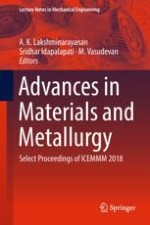This book presents select proceedings of the International Conference on Engineering Materials, Metallurgy and Manufacturing (ICEMMM 2018), and covers topics regarding both the characterization of materials and their applications across engineering domains. It addresses standard materials such as metals, polymers and composites, as well as nano-, bio- and smart materials. In closing, the book explores energy, the environment and green processes as related to materials engineering. Given its content, it will prove valuable to a broad readership of students, researchers, and professionals alike.
